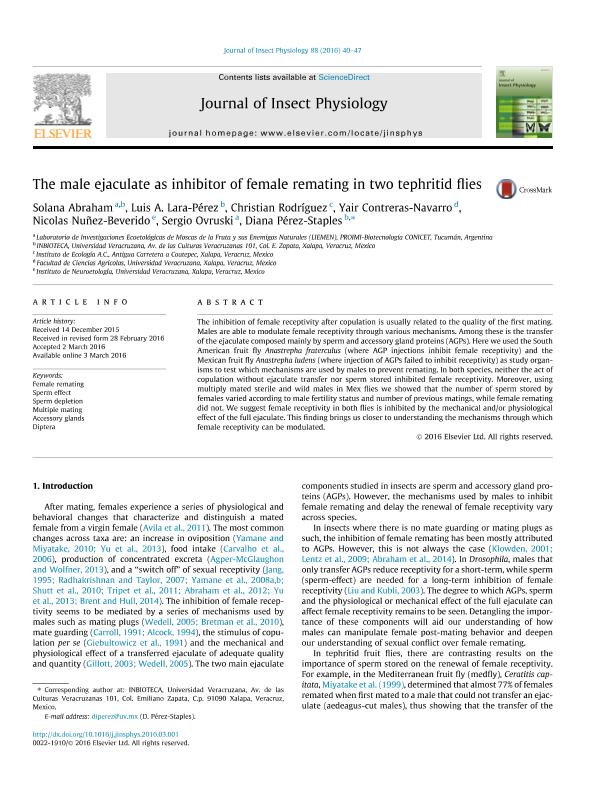Mostrar el registro sencillo del ítem
dc.contributor.author
Abraham, Solana

dc.contributor.author
Lara Pérez, Luis A.
dc.contributor.author
Rodríguez, Christian
dc.contributor.author
Contreras Navarro, Yair
dc.contributor.author
Nuñez Beverido, Nicolas
dc.contributor.author
Ovruski Alderete, Sergio Marcelo

dc.contributor.author
Perez Staples, Diana Folger

dc.date.available
2018-03-02T18:20:28Z
dc.date.issued
2016-05
dc.identifier.citation
Abraham, Solana; Lara Pérez, Luis A.; Rodríguez, Christian; Contreras Navarro, Yair; Nuñez Beverido, Nicolas; et al.; The male ejaculate as inhibitor of female remating in two tephritid flies; Pergamon-Elsevier Science Ltd; Journal of Insect Physiology; 88; 5-2016; 40-47
dc.identifier.issn
0022-1910
dc.identifier.uri
http://hdl.handle.net/11336/37678
dc.description.abstract
The inhibition of female receptivity after copulation is usually related to the quality of the first mating. Males are able to modulate female receptivity through various mechanisms. Among these is the transfer of the ejaculate composed mainly by sperm and accessory gland proteins (AGPs). Here we used the South American fruit fly Anastrepha fraterculus (where AGP injections inhibit female receptivity) and the Mexican fruit fly Anastrepha ludens (where injection of AGPs failed to inhibit receptivity) as study organisms to test which mechanisms are used by males to prevent remating. In both species, neither the act of copulation without ejaculate transfer nor sperm stored inhibited female receptivity. Moreover, using multiply mated sterile and wild males in Mex flies we showed that the number of sperm stored by females varied according to male fertility status and number of previous matings, while female remating did not. We suggest female receptivity in both flies is inhibited by the mechanical and/or physiological effect of the full ejaculate. This finding brings us closer to understanding the mechanisms through which female receptivity can be modulated.
dc.format
application/pdf
dc.language.iso
eng
dc.publisher
Pergamon-Elsevier Science Ltd

dc.rights
info:eu-repo/semantics/openAccess
dc.rights.uri
https://creativecommons.org/licenses/by-nc-nd/2.5/ar/
dc.subject
Accessory Glands
dc.subject
Diptera
dc.subject
Female Remating
dc.subject
Multiple Mating
dc.subject
Sperm Depletion
dc.subject
Sperm Effect
dc.subject.classification
Otras Ciencias Biológicas

dc.subject.classification
Ciencias Biológicas

dc.subject.classification
CIENCIAS NATURALES Y EXACTAS

dc.title
The male ejaculate as inhibitor of female remating in two tephritid flies
dc.type
info:eu-repo/semantics/article
dc.type
info:ar-repo/semantics/artículo
dc.type
info:eu-repo/semantics/publishedVersion
dc.date.updated
2017-12-04T18:00:31Z
dc.journal.volume
88
dc.journal.pagination
40-47
dc.journal.pais
Estados Unidos

dc.description.fil
Fil: Abraham, Solana. Universidad Veracruzana; México. Consejo Nacional de Investigaciones Científicas y Técnicas. Centro Científico Tecnológico Conicet - Tucuman. Planta Piloto de Procesos Industriales Microbiologicos; Argentina
dc.description.fil
Fil: Lara Pérez, Luis A.. Universidad Veracruzana; México
dc.description.fil
Fil: Rodríguez, Christian. Universidad Veracruzana; México
dc.description.fil
Fil: Contreras Navarro, Yair. Universidad Veracruzana; México
dc.description.fil
Fil: Nuñez Beverido, Nicolas. Universidad Veracruzana; México
dc.description.fil
Fil: Ovruski Alderete, Sergio Marcelo. Consejo Nacional de Investigaciones Científicas y Técnicas. Centro Científico Tecnológico Conicet - Tucuman. Planta Piloto de Procesos Industriales Microbiologicos; Argentina
dc.description.fil
Fil: Perez Staples, Diana Folger. Universidad Veracruzana; México
dc.journal.title
Journal of Insect Physiology

dc.relation.alternativeid
info:eu-repo/semantics/altIdentifier/doi/http://dx.doi.org/10.1016/j.jinsphys.2016.03.001
dc.relation.alternativeid
info:eu-repo/semantics/altIdentifier/url/https://www.sciencedirect.com/science/article/pii/S0022191016300233
Archivos asociados
